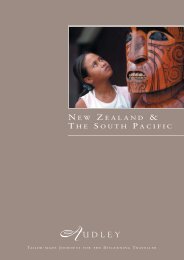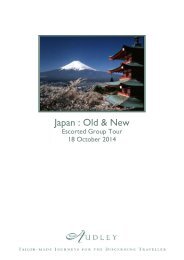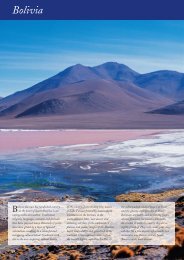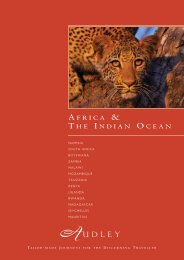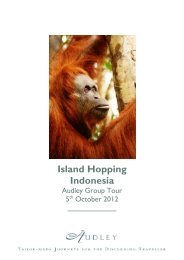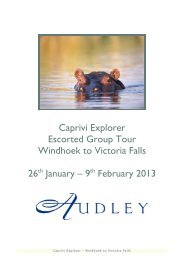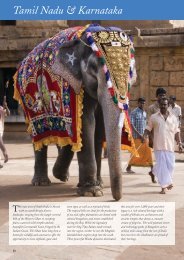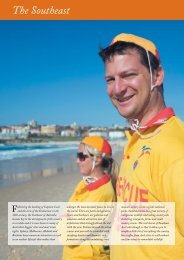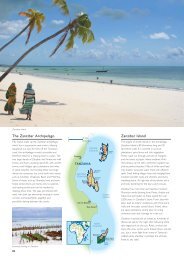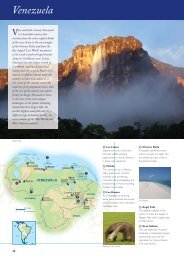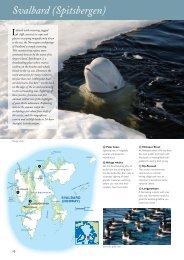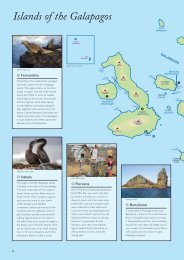Download - Audley Travel
Download - Audley Travel
Download - Audley Travel
You also want an ePaper? Increase the reach of your titles
YUMPU automatically turns print PDFs into web optimized ePapers that Google loves.
Daisetsu-zan National Park<br />
Sapporo & Hakodate<br />
Hokkaido’s capital Sapporo dates back only<br />
120 years, and this bright, cosmopolitan city,<br />
well-endowed with gardens and parks, makes the<br />
perfect base from which to head out and explore<br />
the island. In recent times it has played host to<br />
matches in the 2002 football World Cup and the<br />
1972 Winter Olympics, and each February the<br />
city welcomes the world to the wonderful<br />
Sapporo Snow Festival, an ice-sculpting<br />
extravaganza on an epic scale. Further south,<br />
separated from the mainland by the narrow<br />
Tsugaru Straits, is the charming port town of<br />
Hakodate. There is something of the feel of<br />
Nagasaki here, with the intriguing mixture of<br />
Japanese and Western architecture giving an<br />
unexpectedly international atmosphere. Take a<br />
cable-car at dusk to the summit of Mount<br />
Hakodate and watch as the sparkling lights of<br />
the town radiate out into the distance.<br />
Sapporo Snow Festival<br />
24<br />
Hokkaido’s National Parks<br />
Hokkaido is blessed with stunning natural scenery,<br />
carved by the elements and sculpted by ongoing<br />
volcanic activity. The island is dotted with national<br />
parks, from the picturesque caldera lakes of<br />
Shikotsu-Toya near Sapporo, home to active<br />
volcanoes, to the rugged wilderness of the<br />
bear-haunted Shiretoko Peninsula that juts out<br />
east into the cold Sea of Okhotsk. The centre of<br />
Hokkaido rises to the high peaks of Daisetsu-zan<br />
Hokkaido’s history<br />
Hokkaido’s history is long and, at times,<br />
dark. The island was not settled upon by<br />
mainlanders until the 1600s, when trade<br />
links were established by the ruling<br />
Shogunate clan. This offered the indigenous<br />
Ainu population a chance for wealth and<br />
commerce but was also ultimately their<br />
undoing; they were persecuted and forced<br />
out of their homelands, with some<br />
restrictions lasting until as late as the 1990s.<br />
During this time the Ainu were forced to<br />
learn Japanese, required to adopt Japanese<br />
names and ordered to cease religious<br />
practices such as animal sacrifice and the<br />
custom of tattooing. It was not until 2008<br />
that the Ainu were officially recognised as<br />
National Park, the largest and perhaps most<br />
beautiful region on the island. In summer this is<br />
wonderful walking country, with cable-cars<br />
offering easy access to summits carpeted with<br />
alpine flowers. For those with an interest in bird<br />
watching, winter brings an influx of rare and<br />
spectacular visitors. One of Japan’s national<br />
symbols, the red-crested crane, spends its winters<br />
at Kushiro Wetland National Park, while Akan<br />
National Park and the eastern regions host the<br />
magnificent Steller’s sea eagles.<br />
Sketch of Ainu men in traditional costume<br />
an indigenous group, resulting in better<br />
relations with the mainland and a renaissance<br />
of Ainu traditions. Several Ainu museums<br />
have been set up in Hokkaido giving visitors<br />
to the island a chance to better understand<br />
their history and customs.



